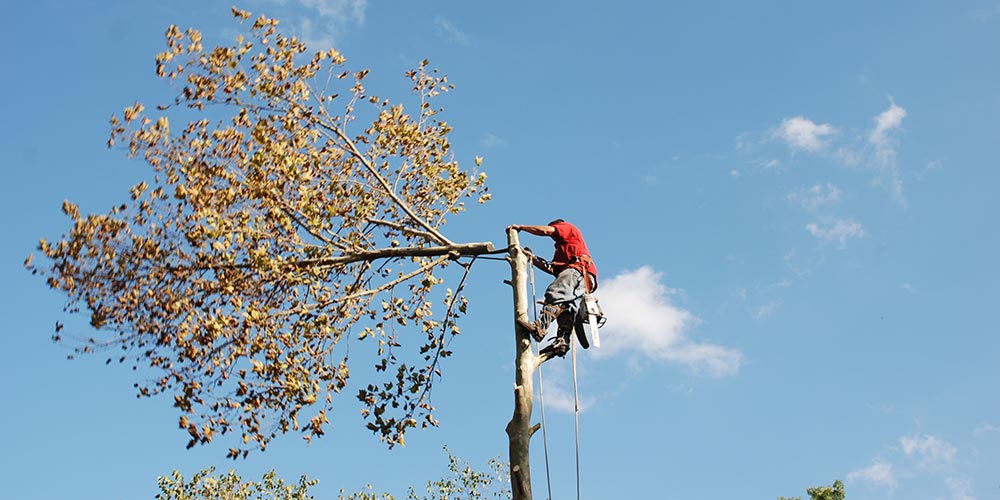
Tree Cutting Best Practices
April 29, 2024
Cutting down a tree is a significant undertaking, but it is not as difficult as you may imagine. You can safely down a tree on your own without the services of tree removal services if you take the necessary measures. Some of the measures you should undertake include:
Ensure there are no hazards nearby
You need to ensure that the tree has adequate space to fall without touching anything. Before you fall the tree, estimate its overall height, then ensure there are no buildings, structures, or electricity lines that it could crash with after being chopped down.
While at it, ensure there are no people, dogs, or other obstructions within this radius.
If the weather prediction predicts rain or wind, you should consider postponing tree-felling plans.
You also should consider postponing if you’re concerned about the location of your tree. Always seek a second assessment from a tree-felling professional before you proceed with the project.
Wear protective gear
Safety equipment protects you while you work with your chainsaw. You should always wear durable, close-toed shoes like leather boots to protect your feet.
Chainsaw chaps or leggings and a long-sleeved top will protect your arms and legs. You also should wear a hard hat and goggles to protect your head and eyes. Also, wear work gloves, earmuffs, or earplugs.
You should use a chainsaw to cut down most trees. If you’re working with a tiny tree or sapling, an axe will suffice; otherwise, a chainsaw is your best option.
A chainsaw with a 16 to 18 in (41 to 46 cm) bar is appropriate for small to medium-sized trees, whereas a 20 to 24 in (51 to 61 cm) bar is better suited for larger trees. Use a larger bar to hack a large tree into firewood.
Know your limits
If you’ve never used a chainsaw before, don’t have all of the necessary safety equipment, or are dealing with a large tree, it’s preferable to hire a professional.
While felling a tree isn’t difficult, it involves planning, focus, and caution, so don’t attempt it when you’re not feeling your best.
Also, check the weather forecast. If it’s pouring or windy, wait until milder weather. If you decide to do it yourself, you must hire an assistant to monitor things while you cut.
As a rule of thumb, don’t attempt to cut down a tree that is too large. You also should avoid one that is too close to the house as chances are that you are going to cause harm to your property.
Get rid of low-hanging branches.
The felling process becomes more complicated if you don’t remove the low-hanging branches. And you don’t want this.
You should note that the branches operate as impediments around the tree’s perimeter, preventing the person cutting down the tree from being in the optimal position to cut.
Furthermore, a large, low limb might cause the tree to roll or tilt to one side as it strikes the ground.
To avoid this, you should always remove the low-hanging branches before bringing down the tree.
Always have a lookout.
As mentioned, don’t try to cut down a tree by yourself, even if the tree is small. The most effective way to ensure a safe fall is to have a dependable lookout.
The lookout should be a few steps behind you, who is felling the tree. They also should have a long stick or pole to keep themselves safe.
Before you start cutting down the tree, create a plan for how your lookout will alert you if there is a problem.
One communication technique is as follows: If the lookout notices trouble—for example, a heavy branch overhead is about to fall—the lookout can use the stick to tap you on the shoulder.
That tap communicates that the task has suddenly become risky and informs you to abandon the chainsaw and walk rapidly away from the immediate area, using preplanned escape paths.
Have escape routes
Once you’ve verified that the tree is safely within your ability to fell, you can clear the area after establishing a fall path and gathering your equipment.
First, remove any pets, people, or other objects from the fall path: plan and clear two escape routes on the non-falling side of the tree.
You’ll use one to escape the tree when it falls safely.
Because falling trees might be unpredictable, it’s a good idea to prepare two escape routes if one falls in an unexpected direction.
The escape routes should be at a 45-degree angle to each other, at least 15 feet long, and pointed directly away from the falling tree. They should also be free of brush, rocks, and other potential tripping hazards.
You should trim any brush around the tree you intend to take down.
While it may appear to be a lot of work to construct escape routes, it is the most effective strategy to reduce the risk of major harm.
Be ultra-cautious when cutting.
The final cut is often the felling cut, when things frequently go awry if you’re not attentive. Move to the opposite side of the tree from the nick you made.
Saw into the tree at the same height as your notch, cutting only deep enough to accommodate your felling wedges.
Do not withdraw your chainsaw from the cut; instead, leave it running while locking the chain brake.
Now, use a mallet or hammer to pound the felling wedges into place behind your chainsaw blade.
In rare circumstances, you may not require the felling wedges if the tree begins to fall on its own.
You should continue chopping through the tree in a horizontal line. Pull out your chainsaw, set the chain brake, and retreat down one of your escape routes until you are at least 15 feet away from the falling tree.
Tree services Chevy Chase advise that you shouldn’t turn your back on the falling tree; keep it in your sight at all times.
